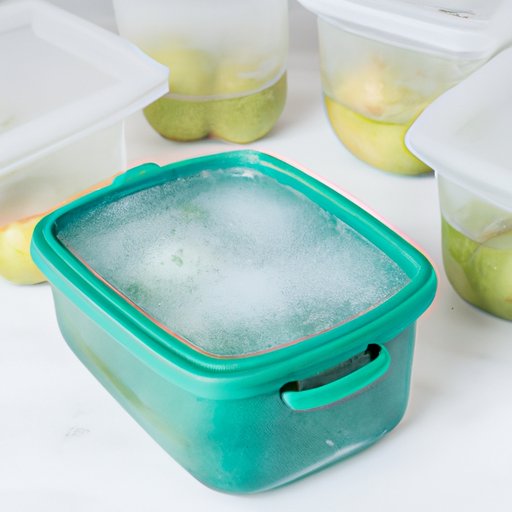
Introduction
Every fall, we eagerly await the arrival of freshly picked pears, but what do you do when you have more than you can eat or donate? Freezing your pears is a great way to make sure they don’t go to waste. In this article, we will provide a comprehensive guide to freezing pears, including saving your harvest, optimizing storage, step-by-step instructions, and best practices for keeping your pears fresh all year long.
Saving Your Harvest: How to Prepare Pears for Freezing
Not all pears are created equal when it comes to freezing. The best pears for freezing are firm, ripe, and sweet. Ideally, they should be picked just before they reach peak ripeness, so they don’t turn mushy in the freezer. To prepare the pears for freezing, first, wash them under running water and pat them dry. Next, peel, core, and slice the pears. To prevent browning, you can use a solution of ascorbic acid or lemon juice, or soak the slices in saltwater for a few minutes. It’s important to maintain the pears’ texture, so avoid blanching the slices before freezing.
Freezing Tips for Optimal Storage
There are a few methods to freeze pears, each with its pros and cons. The dry pack method is the simplest: pack the sliced pears into freezer bags and remove as much air as possible before sealing. This method is best for pears that will be used for cooking, such as in pies or smoothies. Alternatively, the syrup pack method involves packing the pears in a solution of sugar and water that helps maintain their flavor and texture. This method is best for eating pears, as it helps retain their sweetness. Flash freezing is a great option if you want to freeze individual slices for use in recipes. Place the slices on a baking sheet lined with parchment paper and freeze until solid, then transfer to a freezer bag. Regardless of the method used, it’s important to label the bags with the date and contents for easy reference.
Get Ready for Fall with Frozen Pears: A Step-by-Step Guide
The following step-by-step guide is based on the syrup pack method:
- Bring a 30% sugar syrup (3 cups of water and 1.5 cups sugar) to a boil.
- Reduce heat and add sliced pears to the syrup for 1-2 minutes, stirring occasionally.
- Remove from the heat and cool the pears in the syrup for 30 minutes.
- Drain the pears and pack them into freezer-safe containers or bags. Leave an inch of headspace to account for expansion during freezing.
- Label the containers with the date and contents and store them in the freezer at 0°F or below.
Remember, different methods may require slightly different steps, so always refer to the specific method’s instructions.
Freezing Pears 101: The Ultimate Guide to Keeping Your Pears Fresh Longer
Compared to other preservation methods, freezing pears is an excellent way to maintain the fruit’s texture, flavor, and nutrients. When storing frozen pears, it’s crucial to maintain the ideal storage conditions: a freezer temperature of 0°F or below. Properly stored frozen pears can last up to 12 months. To use frozen pears, thaw them in the refrigerator overnight, or use them directly in cooked or baked dishes. Avoid refreezing thawed pears, as it can affect their texture.
From Orchard to Freezer: The Best Way to Freeze Fresh Pears and Enjoy Them All Year Long
Freezing pears is a great way to savor the fall harvest all year long, reducing waste and preserving the fruit’s flavor and nutrients. We hope this comprehensive guide has provided you with all the information you need to freeze your pears successfully. Remember, the key is to choose the right pears, prevent browning, and follow the recommended freezing method. By following these steps, you’ll be able to enjoy sweet, frozen pears in all your favorite dishes throughout the year.
“The act of preserving food is a sign of respect for the earth and our place in it.




